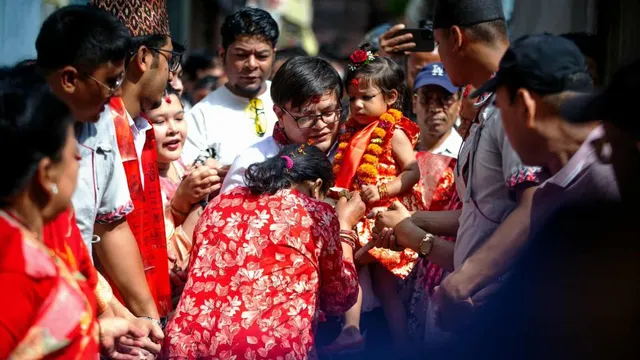- By Ajeet Kumar
- Wed, 01 Oct 2025 03:34 PM (IST)
- Source:JND
A two-and-a-half-year-old girl has been chosen as Nepal's new Kumari, or Living Goddess. Arya Tara Shakya assumed the traditional Kumari throne on Tuesday. She officially entered the Kumari House, located in Basantapur in the heart of Kathmandu, during a special ceremony held at an auspicious time on Tuesday, according to Uddhav Karmacharya, a priest at the Taleju Bhawani Temple in Kathmandu.
Kumari is considered the human form of Goddess Taleju in Hanumandhoka, Kathmandu. Today, the Living Goddess has become one of the main attractions for foreign visitors to Kathmandu. There is a tradition of Nepal's president worshipping the Living Goddess and receiving her blessing during the Indrajatra festival, which falls in August.
Wow😍
— Raghav Mudvari ⚔️🇳🇵 (@Nepali_Comrade) September 30, 2025
Living Goddess Aaryatara Shakya is Kumari of Kathmandu city from today 🕉️ pic.twitter.com/LXUZDVDxjn
How does a living goddess chosen in Nepal?
The Kumari is selected from among Shakya girls before they experience their first menstruation. The outgoing Kumari recently retired at the age of 12 after her first menstruation. The current Kumari is 2 years and 8 months old, according to the priest. She underwent a rigorous selection process to qualify for the role.
To be chosen, she must not have experienced menstruation, have no scratches or wounds on her body, and display fearlessness. As part of the selection process, she is kept in a dark room where a buffalo's head and scary masks are placed, and she must emerge without showing any signs of fear. The new Kumari was chosen by a selection team a few days ago.
The Kumari is worshipped by both Hindus and Buddhists. Although the Shakya community, from which the Kumari is selected, is considered Buddhist, the Kumari is revered as a Hindu goddess. This duality symbolises the centuries-old religious harmony that exists in Nepal.
My wife during pregnancy dreamed that she was a goddess: Father
Family, friends and devotees paraded the new Kumari through the streets of Kathmandu before entering the temple palace, which will be her home for several years. “She was just my daughter yesterday, but today she is a goddess,” her father Ananta Shakya said, adding that there were already signs she would be the goddess before her birth. “My wife during pregnancy dreamed that she was a goddess and we knew she was going to be someone very special.”
The tradition of worshipping the Living Goddess, or Kumari, dates back approximately 500 to 600 years, during the reign of the Malla Kings. However, the tradition of parading the Kumari in a special chariot through the core areas of Kathmandu began during the time of the last Malla King, Jaya Prakash Malla, in the mid-18th century. The Kumari Ghar, or the special house for the Kumari, was also constructed during this period.
Difficulties of being a Kumari in Nepal
The former Kumari Trishna Shakya, now aged 11 years old, left from a rear entrance on a palanquin carried by her family and supporters. She became the living goddess in 2017.
Families of the Shakya clan who qualify for the prestigious seat compete to have their daughters selected. The family of the Kumari gains an elevated position in society and within their own clan. But Kumaris live a sequestered life. They have few selected playmates and are allowed outside only a few times a year for festivals.
Man who marry a former Kumari will die young: Nepalese folklore
Former Kumaris face difficulties adjusting to normal life, learning to do chores and attending regular schools. Nepalese folklore says men who marry a former Kumari will die young, which has resulted in many of the girls remaining unmarried.
Over the past few years, there have been many changes in tradition and the Kumari is now allowed to receive an education from private tutors inside the temple palace and even have a television set. The government also offers retired Kumaris a small monthly pension of about $110, which is slightly above the minimum wage fixed by the government.
(With inputs from agencies)

